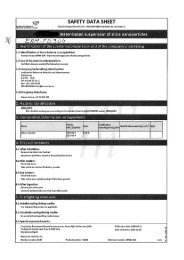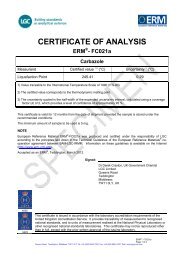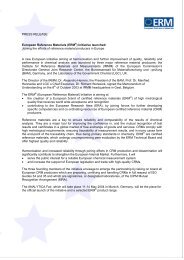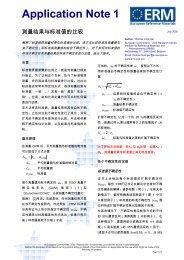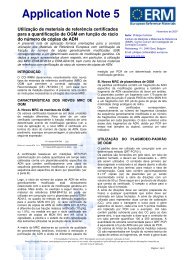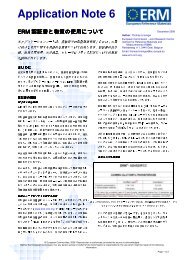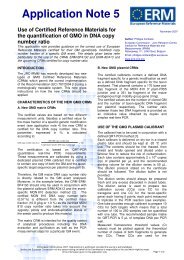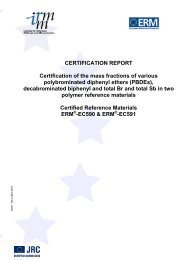Certification Report Certified Reference Material ERM - European ...
Certification Report Certified Reference Material ERM - European ...
Certification Report Certified Reference Material ERM - European ...
You also want an ePaper? Increase the reach of your titles
YUMPU automatically turns print PDFs into web optimized ePapers that Google loves.
in cooperation with the WG ’Precious Metals’<br />
of the Committee of Chemists of GDMB<br />
<strong>Certification</strong> <strong>Report</strong><br />
<strong>Certified</strong> <strong>Reference</strong> <strong>Material</strong><br />
<strong>ERM</strong> ® -EZ505<br />
Electronic Scrap<br />
January 2011
Coordinator: Dr. Sebastian Recknagel<br />
BAM Federal Institute for <strong>Material</strong>s Research and Testing<br />
Richard-Willstätter-Straße 11<br />
12489 Berlin<br />
Tel.: ++49/30/8104 1111<br />
Fax.: ++49/30/8104 1117<br />
Email: sebastian.recknagel@bam.de<br />
Working Group „Metal Analysis; Inorganic <strong>Reference</strong> <strong>Material</strong>s“<br />
2
Summary<br />
This report describes preparation, analysis and certification of the electronic scrap reference<br />
material <strong>ERM</strong> ® -EZ505.<br />
The certified reference material can be used for chemical analysis of minor elements and<br />
traces in similar materials. It is intended for development, validation and quality control of<br />
analytical methods and procedures.<br />
<strong>Certified</strong> reference material <strong>ERM</strong> ® -EZ505 is available as powder with a particle size<br />
< 150 µm.<br />
The following mass fractions and uncertainties have been certified:<br />
Element Mass fraction Uncertainty<br />
in % in %<br />
Cu 15.10 0.11<br />
Ni 0.470 0.008<br />
in mg/kg in mg/kg<br />
Ag 692 13<br />
Au 292 4<br />
Be 68.8 2.3<br />
In 91 7<br />
Pd 90.5 2.4<br />
Pt 8.5 0.8<br />
This report contains detailed information on the preparation of the CRM as well as on<br />
homogeneity investigations and on the analytical methods used for certification analysis.<br />
The certified values are based on the results of 19 laboratories which participated in the<br />
certification interlaboratory comparison.<br />
3
Content<br />
1. Introduction ........................................................................................................................6<br />
2. Companies/laboratories involved........................................................................................6<br />
3. Candidate material .............................................................................................................7<br />
4. Homogeneity testing...........................................................................................................7<br />
5. Stability...............................................................................................................................9<br />
6. <strong>Certification</strong> study...............................................................................................................9<br />
4<br />
Page<br />
6.1 Analytical methods....................................................................................................... 9<br />
6.2 Analytical results and statistical evaluation .................................................................14<br />
7. Instructions for users........................................................................................................27<br />
8. Literature..........................................................................................................................27<br />
9. Information on and purchase of the CRM.........................................................................27
List of abbreviations<br />
(if not explained elsewhere)<br />
CRM certified reference material<br />
<strong>ERM</strong> <strong>European</strong> reference material<br />
ETAAS electrothermal atomic absorption spectrometry<br />
FAAS flame atomic absorption spectrometry<br />
ICP-MS inductively coupled plasma mass spectrometry<br />
ICP-OES inductively coupled plasma optical emission spectrometry<br />
M arithmetic mean of means<br />
n number of accepted data sets<br />
NAA neutron activation analysis<br />
SD standard deviation of an individual data set<br />
SDM<br />
standard deviation of the mean of means<br />
5
1. Introduction<br />
Printed circuit boards are a source for precious metals of economic interest. The price for<br />
used printed circuit boards is related to their precious metals content and on the current<br />
price for metals like silver, gold, platinum and palladium. Resulting from the high price for<br />
precious metals, an accurate determination of these elements is necessary. To ensure this,<br />
certified reference materials either for calibration and quality control are required.<br />
The idea to produce a reference material based on electronic scrap is the outcome of the<br />
discussions within the German Gesellschaft für Bergbau, Metallurgie, Rohstoff- und<br />
Umwelttechnik (GDMB) and especially the working group „precious metals“ of the committee<br />
of chemists within GDMB. From this working group the needs are defined, since the<br />
members are potential users of the prepared CRMs. Secondly from this group the<br />
participating laboratories are recruited. Since all of these laboratories are highly experienced<br />
with precious metals analysis there was no preceding round robin test for qualification. Most<br />
of the participants had an accreditation or a certification according to ISO 17025 or 9001.<br />
<strong>Certification</strong> of reference materials is carried out on the basis of the relevant ISO-Guides [1-<br />
3], the „Guidelines for the production of BAM <strong>Reference</strong> <strong>Material</strong>s“ [4] and the “Technical<br />
Guidelines for the Production and Acceptance of a <strong>European</strong> <strong>Reference</strong> <strong>Material</strong>” [5].<br />
Starting material for the preparation of CRM <strong>ERM</strong> ® -EZ505 were approx. 40 kg of used mixed<br />
printed circuit boards.<br />
2. Companies/laboratories involved<br />
Preparation of the material:<br />
− G + S Gesellschaft für Labortechnik und Probenaufbereitung mbH<br />
Test for homogeneity:<br />
− Allgemeine Gold- und Silberscheideanstalt AG<br />
− W.C. Heraeus GmbH<br />
− Institut für <strong>Material</strong>prüfung Glörfeld GmbH<br />
− BAM Bundesanstalt für <strong>Material</strong>forschung und -prüfung<br />
Participants in the certification interlaboratory comparison:<br />
− Alfred Knight Int. Ltd, St. Helens (United Kingdom)<br />
− Allgemeine Gold- und Silberscheideanstalt AG, Pforzheim (Germany)<br />
− AMI Doduco GmbH, Pforzheim (Germany)<br />
− Aurubis AG, Hamburg (Germany)<br />
− BAM Bundesanstalt für <strong>Material</strong>forschung und -prüfung, Berlin (Germany)<br />
− Forschungsinstitut Edelmetalle & Metallchemie, Schwäbisch Gmünd (Germany)<br />
− Horiba Scientific, Unterhaching, (Germany)<br />
− Inspectorate International Ltd, Reno NV (United States)<br />
− Inspectorate International Ltd, Witham (United Kingdom)<br />
− Institut für <strong>Material</strong>prüfung Glörfeld GmbH, Willich (Germany)<br />
− Ledoux & Company, Teanec NJ (United States)<br />
− Nickelhütte Aue GmbH, Aue (Germany)<br />
6
− SAXONIA Edelmetallrecycling GmbH, Halsbrücke (Germany)<br />
− Umicore AG & Co. KG, Hanau (Germany)<br />
− Umicore Precious Metals, Hoboken (Belgium)<br />
− Varian, Darmstadt (Germany)<br />
− W.C. Heraeus GmbH, Hanau (Germany)<br />
− Wieland Edelmetalle GmbH & Co, Pforzheim (Germany)<br />
− WRC World Resources Company GmbH, Wurzen (Germany)<br />
Statistical evaluation of the data<br />
− BAM Bundesanstalt für <strong>Material</strong>forschung und -prüfung, Berlin<br />
3. Candidate material<br />
Approx. 40 kg of used mixed printed circuit boards were taken as initial material. These<br />
boards were doped with Be, In and Pt, ashed and melted with approx. 40 kg of pyrite (FeS2).<br />
After milling and grinding the material was sieved to a particle size below 150 µm and<br />
homogenised thoroughly. The material was then bottled in 200 ml amber glass containers<br />
each filled with 200 g of material. The bottles were sealed with screw caps equipped with PE<br />
insert and with shrinking foil. In total 250 bottles were filled.<br />
4. Homogeneity testing<br />
Three laboratories performed analyses for homogeneity testing. Each laboratory received<br />
five randomly chose bottles (Table 1). The laboratories were asked to analyse all elements<br />
once in four bottles and four times in the fifth bottle. Lab. 3 carried out additional analyses on<br />
all five bottles (3 to 6 single results depending on the element).<br />
Table 1: Homogeneity testing, chosen bottles (in brackets: number of single results)<br />
Laboratory-No. 1 2 3<br />
Bottle-No. 3 (4) 10 (1) 122 (3-6)<br />
54 (1) 28 (1) 143 (3-6)<br />
111 (1) 48 (1) 159 (3-6)<br />
202 (1) 118 (4) 179 (3-6)<br />
222 (1) 147 (1) 241 (3-6)<br />
From the data of each laboratory an estimator for the inhomogeneity contribution was<br />
calculated according to Eqs. 1 - 6.<br />
MS<br />
bw,<br />
i<br />
=<br />
ni<br />
∑<br />
k = 1<br />
dev<br />
i<br />
k , i<br />
n −1<br />
ni = number of bottles tested in the ith laboratory (k = 1… ni)<br />
( ) 2<br />
M M<br />
dev = p ⋅ −<br />
(2)<br />
k,<br />
i k,<br />
i bottle _ k total , i<br />
7<br />
(1)
with M being mean values (for the bottle or grand mean, respectively; bw means “between”,<br />
wi means “within”), and pk,i the number of single values obtained for bottle k in laboratory i.<br />
MS<br />
wi,<br />
i<br />
*<br />
ni<br />
2<br />
∑ sk<br />
, i<br />
k = 1<br />
*<br />
ni<br />
= (3)<br />
sk,i = standard deviation of single values obtained on bottle k<br />
* *<br />
ni = number of estimates sk,i available in laboratory i (ni = 1 for laboratories 1 and 2)<br />
MS<br />
s<br />
bb,<br />
i<br />
MS<br />
s<br />
bw,<br />
i<br />
=<br />
bw,<br />
i<br />
bb,<br />
i,<br />
min<br />
> MS<br />
=<br />
MS<br />
< MS<br />
wi , i<br />
bw,<br />
i<br />
wi , i<br />
MS<br />
f<br />
:<br />
− MS<br />
f<br />
:<br />
wi , i<br />
⋅<br />
wi , i<br />
2<br />
p −1<br />
i<br />
for laboratories 1 and 2 with an effective degree of freedom f = 1.4 and<br />
MS<br />
s<br />
bw,<br />
i<br />
bb,<br />
i,<br />
min<br />
< MS<br />
=<br />
wi , i<br />
MS<br />
f<br />
wi , i<br />
⋅<br />
ni<br />
∑<br />
k =1<br />
p<br />
2<br />
k,<br />
i<br />
− n<br />
i<br />
for laboratory 3 with f = 3.5. Note that in Equation 5 (for laboratories 1 and 2), the pi refers to<br />
the number of replicate measurements taken from one single bottle, the only data providing<br />
MSwi,i estimates for these laboratories.<br />
Table 2: Homogeneity testing, sample intake in g<br />
Laboratory-No. 1 2 3<br />
Element<br />
Cu 5 5 4.5<br />
Ni 5 5 4.5<br />
In 5 5 4.5<br />
Ag 5 5 2.3<br />
Au 5 5 2.3<br />
Pd 5 5 2.3<br />
Pt 5 5 2.3<br />
Be 5 5 4.5<br />
Comparing sbb,i with sbb,i,min the higher value was used as an estimator of ubb,i for laboratory i,<br />
and converted into a relative uncertainty contribution. The averaged relative estimator for<br />
inhomogeneity ubb to be included in the uncertainty budget of the certified value in<br />
8<br />
(4)<br />
(5)<br />
(6)
accordance with [3] was then calculated by quadratic averaging of the resp. relative<br />
laboratory estimators. Table 3 shows the resp. estimators for inhomogeneity.<br />
Since most of the data for inhomogeneity estimation were produced on the basis of a sample<br />
intake of 5 g, the minimum sample intake for the use of the certified reference material is<br />
5 g.<br />
Table 3: Estimated inhomogeneity, ubb (ubb,abs for Cu, Ni in %, for all other elements in<br />
mg/kg)<br />
Element ubb,rel ubb,abs<br />
Cu 0.27 % 0.0406<br />
Ni 0.47 % 0.00221<br />
In 2.32 % 2.11<br />
Ag 0.76 % 5.25<br />
Au 0.43 % 1.26<br />
Pd 0.88 % 0.797<br />
Pt 3.60 % 0.307<br />
Be 0.78 % 0.537<br />
5. Stability<br />
There is no instability of the certified material to be expected (calcinated inorganic material) if<br />
the material is stored at ambient temperature. To be sure that no oxidation of the matrix<br />
appears, the mass of three individual bottles will be checked regularily every six month. An<br />
expiry date of 10 years is given.<br />
6. <strong>Certification</strong> study<br />
6.1 Analytical methods<br />
19 laboratories participated in the certification interlaboratory comparison. Each laboratory<br />
received one randomly chosen bottle with approx. 200 g of powder. Before analysis the<br />
material had to be dried at 105 °C for at least 8 hours.<br />
The laboratories were told to analyse six subsamples. They were free to choose any suitable<br />
analytical method for analysis. Tables 5 to 12 show the analytical methods used by the<br />
participating laboratories. It is noticeable that often the sample intake is below 5 g, the<br />
sample intake used for homogeneity testing. The spread of single results from laboratories<br />
using less than 5 g for analysis gave no hint that the material was not homogeneous (n.a.<br />
means not available).<br />
For all analytical methods where a calibration was necessary this calibration was performed<br />
using liquid standard solutions. All participating laboratories were asked to use only standard<br />
solutions prepared from pure metals or stoichiometric compounds or well checked<br />
commercial calibration solutions.<br />
9
Table 5: Analytical procedures for the determination of copper<br />
Method Lab-No. Sample Sample pretreatment Analytical method<br />
(Abbrev.)<br />
mass<br />
I 6 1 g Aqua regia/microwave ICP OES with Sc as internal standard<br />
E 4 3 g Electrogravimetry<br />
E 15 n.a. Dissolution with HNO3/H2SO4,<br />
fuming with Br2/HBr<br />
Electrogravimetry<br />
I 16, 18 n.a. Dissolution with aqua regia ICP OES<br />
E 19 2 g Dissolution with aqua regia, fuming<br />
with H2SO4<br />
Electrogravimetry<br />
E 1 n.a. 3 x acid dissolution,<br />
Electrogravimetry<br />
3 x dissolution with aqua regia X-ray fluorescence<br />
I 14 0.2 g Dissolution with HNO3 ICP OES with Y as internal standard<br />
E 10 2 g Dissolution in acid mixture Electrogravimetry<br />
A 13 1 g Fusion with Na2O2 and Na/Kcarbonate,<br />
dissolution in HCl<br />
FAAS<br />
I 3 n.a. n.a. ICP OES bracketing<br />
I 7 4.5 g HCl-digestion/HNO3/Na2O2 fusion ICP OES<br />
E 5 n.a. Dissolution in HNO3, Addition of HCl<br />
and HF, fuming with H2SO4<br />
Electrogravimetry<br />
Table 6: Analytical procedures for the determination of nickel<br />
Method Lab-No. Sample Sample pretreatment Analytical method<br />
(Abbrev.)<br />
mass<br />
I 6 1 g Aqua regia/microwave ICP OES with Sc as internal standard<br />
I 4 1 g Dissolution in acids ICP OES<br />
I 15 n.a. Dissolution with HNO3/H2SO4,<br />
fuming with Br2/HBr<br />
ICP OES<br />
I 16, 18 n.a. Dissolution with aqua regia ICP OES<br />
I 1 0.25 g Microwave dissolution ICP OES<br />
X 1 n.a. Melting with K2S2O7 X-ray fluorescence<br />
I 9 0.4 g Dissolution with HCl/aqua regia,<br />
melting with Na2O<br />
ICP OES<br />
I 14 0.2 g Dissolution with HNO3 ICP OES with Y as internal standard<br />
A 10 2 g Dissolution in acid mixture FAAS<br />
A 13 1 g Fusion with Na2O2 and Na/Kcarbonate,<br />
dissolution in HCl<br />
FAAS<br />
I 3 n.a. n.a. ICP OES bracketing<br />
I 7 4.5 g HCl-digestion/HNO3/Na2O2 fusion ICP OES<br />
I 5 n.a. Acid dissolution ICP OES<br />
10
Table 7: Analytical procedures for the determination of beryllium<br />
Method Lab-No. Sample Sample pretreatment Analytical method<br />
(Abbrev.)<br />
mass<br />
I 6 1 g Aqua regia/microwave ICP OES with Sc as internal standard<br />
E 15 n.a. HNO3/HF/microwave ETAAS<br />
I 16 n.a. Dissolution with aqua regia ICP OES<br />
I 19 2 g Dissolution with aqua regia, fuming<br />
with H2SO4, decomposition of<br />
residue with Na2O2<br />
ICP OES<br />
I 1 0.25 g Microwave dissolution ICP OES<br />
I 9 1 g Dissolution with aqua regia ICP OES<br />
I 14 2 g Dissolution with HNO3 ICP OES with Y as internal standard<br />
A 10 1 g Dissolution with acid mixture/<br />
alkaline fusion<br />
FAAS<br />
I 3 n.a. n.a. ICP OES bracketing<br />
I 5 n.a. Acid dissolution ICP OES<br />
Table 8: Analytical procedures for the determination of indium<br />
Method Lab-No. Sample Sample pretreatment Analytical method<br />
(Abbrev.)<br />
mass<br />
I 6 1 g Aqua regia/microwave ICP OES with Sc as internal standard<br />
E 15 n.a. HNO3/HF/microwave ETAAS<br />
I 16 n.a. Dissolution with aqua regia ICP OES<br />
I 19 2 g Dissolution with aqua regia, fuming<br />
with H2SO4, decomposition of<br />
residue with Na2O2<br />
ICP OES<br />
I 1 0.25 g Microwave dissolution ICP OES<br />
I 10 1 g Dissolution in acid mixture ICP OES<br />
I 5 n.a. Acid dissolution ICP OES<br />
I 3 5 g Dissolution in HCl/HNO3/HF ICP OES<br />
NAA 20 0.1 g Neutron activation analysis<br />
I 21 5 g Dissolution in HCl/HNO3/HF ICP OES<br />
I 22 5 g Dissolution in HCl/HNO3/HF ICP OES<br />
IMS 20 5 g Dissolution in HCl/HNO3/HF ICP-MS<br />
11
Table 9: Analytical procedures for the determination of gold<br />
Method Lab-No. Sample Sample pretreatment Analytical method<br />
(Abbrev.)<br />
mass<br />
I 6 1 g Fire assay with lead, dissolution in<br />
aqua regia<br />
ICP OES with Sc as internal standard<br />
G 4 10 g Fire assay with lead Gravimetry<br />
I 2 n.a. Fire assay with lead, dissolution in<br />
aqua regia<br />
ICP OES with Sc as internal standard<br />
I 15 5 g Fire assay with lead ICP OES<br />
I 16 n.a. Melting with nitrate ICP OES<br />
I 18 n.a. Fire assay with lead ICP OES<br />
O 1 n.a. Fire assay with lead Spark-OES<br />
I 1 n.a. Fire assay, lead collection,<br />
dissolution in aqua regia<br />
ICP OES<br />
I 14 10 g Fire assay, collection with Cu2O,<br />
dissolution in aqua regia<br />
ICP OES with Y as internal standard<br />
I 10 10 g Fire assay, collection with lead ICP OES<br />
G 13 5 g Fire assay with litharge flux/ dilution<br />
in HNO3<br />
Gravimetry<br />
I 3 n.a. n.a. ICP OES bracketing<br />
I 7 2.3 g Fire assay, collection with lead ICP OES<br />
I 5 n.a. Fire assay, collection with lead ICP OES, In as internal standard<br />
Table 10: Analytical procedures for the determination of silver<br />
Method Lab-No. Sample Sample pretreatment Analytical method<br />
(Abbrev.)<br />
mass<br />
I 6 1 g Fire assay with lead, dissolution in<br />
aqua regia<br />
ICP OES with Sc as internal standard<br />
I 2 n.a. Fire assay with lead, dissolution in<br />
aqua regia<br />
ICP OES with Sc as internal standard<br />
I 15 5 g Fire assay with lead ICP OES<br />
I 16 n.a. Melting with nitrate ICP OES<br />
I 18 n.a. Fire assay with lead ICP OES<br />
O 1 n.a. Fire assay with lead Spark-OES<br />
A 10 1 g Dissolution in acid mixture FAAS<br />
A 13 1 g Fusion with Na2O2 and Na/Kcarbonate,<br />
dissolution in HCl<br />
FAAS<br />
I 7 2.3 g Fire assay, collection with lead ICP OES<br />
I 5 n.a. Fire assay, collection with lead ICP OES, In as internal standard<br />
12
Table 11: Analytical procedures for the determination of palladium<br />
Method Lab-No. Sample Sample pretreatment Analytical method<br />
(Abbrev.)<br />
mass<br />
I 6 1 g Fire assay with lead, dissolution in<br />
aqua regia<br />
ICP OES with Sc as internal standard<br />
I 4 10 g Fire assay with lead ICP OES<br />
I 2 n.a. Fire assay with lead, dissolution in<br />
aqua regia<br />
ICP OES with Sc as internal standard<br />
I 15 5 g Fire assay with lead ICP OES<br />
I 16 n.a. Melting with nitrate ICP OES<br />
I 18 n.a. Fire assay with lead ICP OES<br />
I 19 5 g Fire assay, Cu-collection ICP OES with internal standard<br />
O 1 n.a. Fire assay with lead Spark-OES<br />
I 1 n.a. Fire assay, lead collection,<br />
dissolution in aqua regia<br />
ICP OES<br />
I 9 5 g Fire assay with lead, dissolution in<br />
aqua regia<br />
ICP OES<br />
I 14 10 g Fire assay, collection with Cu2O,<br />
dissolution in aqua regia<br />
ICP OES with Y as internal standard<br />
I 10 10 g Fire assay, collection with lead ICP OES<br />
I 13 5 g Fire assay with litharge flux/ dilution<br />
in HNO3<br />
ICP OES<br />
I 3 5 g Fire assay, nitrate fusion ICP OES<br />
I 7 2.3 g Fire assay, collection with lead ICP OES<br />
I 5 n.a. Fire assay, collection with lead ICP OES, In as internal standard<br />
Table 12: Analytical procedures for the determination of platinum<br />
Method Lab-No. Sample Sample pretreatment Analytical method<br />
(Abbrev.)<br />
mass<br />
I 6 1 g Fire assay with lead, dissolution in<br />
aqua regia<br />
ICP OES with Sc as internal standard<br />
I 4 10 g Fire assay with lead ICP OES<br />
I 2 n.a. Fire assay with lead, dissolution in<br />
aqua regia<br />
ICP OES with Sc as internal standard<br />
I 15 5 g Fire assay with lead ICP OES<br />
I 16 n.a. Nitrate fusion ICP OES<br />
I 18 n.a. Fire assay with lead ICP OES<br />
I 19 2 g Fire assay, Pb-collection ICP OES with internal standard<br />
O 1 n.a. Fire assay with lead Spark-OES<br />
I 1 n.a. Fire assay, lead collection,<br />
dissolution in aqua regia<br />
ICP OES<br />
I 9 5 g Fire assay with lead, dissolution in<br />
aqua regia<br />
ICP OES<br />
I 14 10 g Fire assay, collection with Cu2O,<br />
dissolution in aqua regia<br />
ICP OES with Y as internal standard<br />
I 10 10 g Fire assay, collection with lead ICP OES<br />
I 13 5 g Fire assay with litharge flux/ dilution<br />
in HNO3<br />
ICP OES<br />
I 3 5 g Fire assay, nitrate fusion ICP OES<br />
I 7 2.3 g Fire assay, collection with lead ICP OES<br />
I 5 n.a. Fire assay, collection with lead ICP OES, In as internal standard<br />
13
6.2 Analytical results and statistical evaluation<br />
The analytical results of the certification interlaboratory comparison are listed in Tables 15 to<br />
22. These tables show the single results (EW) of each laboratory, the resp. laboratories’<br />
mean values (MW) together with the innerlaboratory standard deviation (s) and in addition<br />
the mean standard deviation ( s ) of all laboratories. The continous line markes the certified<br />
value (mean od the laboratories’ means), the broken lines mark the standard deviation,<br />
calculated from the laboratories’ means.<br />
In the related figures for each laboratory its mean value and single standard deviation is<br />
given.<br />
The statistical evaluation of the data was performed using the software program SoftCRM<br />
1.2.2. [6]. The following results were received:<br />
Copper:<br />
Number of data sets 13<br />
Snedecor-F-Test and Bartlett-Test Pooling not allowed<br />
Dixon (a = 0.05) ---<br />
Dixon (a = 0.01) ---<br />
Nalimov (a = 0.05) Laboratory 14<br />
Nalimov (a = 0.01) ---<br />
Grubbs (a = 0.05) ---<br />
Grubbs (a = 0.01) ---<br />
Grubbs Pair (a = 0.05) ---<br />
Grubbs Pair (a = 0.01) ---<br />
Cochran ---<br />
Kolmogorov-Smirnov-Lilliefors Test (a = 0.05) Distribution: normal<br />
Kolmogorov-Smirnov-Lilliefors Test (a = 0.01) Distribution: normal<br />
The outlying value (Lab. 14) was not removed.<br />
Nickel:<br />
Number of data sets 13<br />
Snedecor-F-Test and Bartlett-Test Pooling not allowed<br />
Dixon (a = 0.05) ---<br />
Dixon (a = 0.01) ---<br />
Nalimov (a = 0.05) Laboratory 6<br />
Nalimov (a = 0.01) ---<br />
Grubbs (a = 0.05) ---<br />
Grubbs (a = 0.01) ---<br />
Grubbs Pair (a = 0.05) ---<br />
Grubbs Pair (a = 0.01) ---<br />
Cochran ---<br />
Kolmogorov-Smirnov-Lilliefors Test (a = 0.05) Distribution: normal<br />
Kolmogorov-Smirnov-Lilliefors Test (a = 0.01) Distribution: normal<br />
The outlying value (Lab. 6) was not removed.<br />
14
Indium:<br />
Number of data sets 12<br />
Snedecor-F-Test and Bartlett-Test Pooling not allowed<br />
Dixon (a = 0.05) ---<br />
Dixon (a = 0.01) ---<br />
Nalimov (a = 0.05) ---<br />
Nalimov (a = 0.01) ---<br />
Grubbs (a = 0.05) ---<br />
Grubbs (a = 0.01) ---<br />
Grubbs Pair (a = 0.05) ---<br />
Grubbs Pair (a = 0.01) ---<br />
Cochran ---<br />
Kolmogorov-Smirnov-Lilliefors Test (a = 0.05) Distribution: not normal<br />
Kolmogorov-Smirnov-Lilliefors Test (a = 0.01) Distribution: normal<br />
Beryllium:<br />
Number of data sets 10<br />
Snedecor-F-Test and Bartlett-Test Pooling not allowed<br />
Dixon (a = 0.05) ---<br />
Dixon (a = 0.01) ---<br />
Nalimov (a = 0.05) Laboratory 10<br />
Nalimov (a = 0.01) ---<br />
Grubbs (a = 0.05) ---<br />
Grubbs (a = 0.01) ---<br />
Grubbs Pair (a = 0.05) ---<br />
Grubbs Pair (a = 0.01) ---<br />
Cochran ---<br />
Kolmogorov-Smirnov-Lilliefors Test (a = 0.05) Distribution: normal<br />
Kolmogorov-Smirnov-Lilliefors Test (a = 0.01) Distribution: normal<br />
The outlying value (Lab. 10) was not removed.<br />
15
Silver:<br />
Number of data sets 12<br />
Snedecor-F-Test and Bartlett-Test Pooling not allowed<br />
Dixon (a = 0.05) ---<br />
Dixon (a = 0.01) ---<br />
Nalimov (a = 0.05) Laboratory 2<br />
Nalimov (a = 0.01) ---<br />
Grubbs (a = 0.05) ---<br />
Grubbs (a = 0.01) ---<br />
Grubbs Pair (a = 0.05) ---<br />
Grubbs Pair (a = 0.01) ---<br />
Cochran ---<br />
Kolmogorov-Smirnov-Lilliefors Test (a = 0.05) Distribution: normal<br />
Kolmogorov-Smirnov-Lilliefors Test (a = 0.01) Distribution: normal<br />
The outlying value (Lab. 2) was not removed.<br />
Palladium:<br />
Number of data sets 16<br />
Snedecor-F-Test and Bartlett-Test Pooling not allowed<br />
Dixon (a = 0.05) ---<br />
Dixon (a = 0.01) ---<br />
Nalimov (a = 0.05) Laboratory 19<br />
Nalimov (a = 0.01) ---<br />
Grubbs (a = 0.05) ---<br />
Grubbs (a = 0.01) ---<br />
Grubbs Pair (a = 0.05) ---<br />
Grubbs Pair (a = 0.01) ---<br />
Cochran ---<br />
Kolmogorov-Smirnov-Lilliefors Test (a = 0.05) Distribution: normal<br />
Kolmogorov-Smirnov-Lilliefors Test (a = 0.01) Distribution: normal<br />
The outlying value (Lab. 19) was not removed.<br />
16
Gold:<br />
Number of data sets 11<br />
Snedecor-F-Test and Bartlett-Test Pooling not allowed<br />
Dixon (a = 0.05) ---<br />
Dixon (a = 0.01) ---<br />
Nalimov (a = 0.05) Laboratory 10<br />
Nalimov (a = 0.01) ---<br />
Grubbs (a = 0.05) ---<br />
Grubbs (a = 0.01) ---<br />
Grubbs Pair (a = 0.05) ---<br />
Grubbs Pair (a = 0.01) ---<br />
Cochran ---<br />
Kolmogorov-Smirnov-Lilliefors Test (a = 0.05) Distribution: normal<br />
Kolmogorov-Smirnov-Lilliefors Test (a = 0.01) Distribution: normal<br />
The outlying value (Lab. 10) was not removed.<br />
Platinum:<br />
Number of data sets 15<br />
Snedecor-F-Test and Bartlett-Test Pooling not allowed<br />
Dixon (a = 0.05) ---<br />
Dixon (a = 0.01) ---<br />
Nalimov (a = 0.05) ---<br />
Nalimov (a = 0.01) ---<br />
Grubbs (a = 0.05) ---<br />
Grubbs (a = 0.01) ---<br />
Grubbs Pair (a = 0.05) ---<br />
Grubbs Pair (a = 0.01) ---<br />
Cochran ---<br />
Kolmogorov-Smirnov-Lilliefors Test (a = 0.05) Distribution: normal<br />
Kolmogorov-Smirnov-Lilliefors Test (a = 0.01) Distribution: normal<br />
The certified mass fractions of all elements were calculated as mean of the accepted data<br />
sets. These values are given in Table 13.<br />
The resp. combined uncertainties were calculated from the spread resulting from the<br />
certification interlaboratory comparison and the uncertainty contribution from possible<br />
inhomogeneity of the material using Equation 7.<br />
u<br />
s<br />
2<br />
ilc 2<br />
combined = n+<br />
ubb<br />
with<br />
17<br />
(7)
s<br />
2<br />
ilc n:<br />
spread resulting from interlaboratory comparison<br />
n : number of data sets used for calculating the certified mass fraction of each element<br />
Table 13: Uncertainty calculation<br />
MW n silc ubb<br />
copper 15.10 % 14 0.11 % 0.041 %<br />
nickel 0.47 % 14 0.01 % 0.00221 %<br />
silver 692 mg/kg 13 13 mg/kg 5.26 mg/kg<br />
gold 292 mg/kg 15 5 mg/kg 1.26 mg/kg<br />
beryllium 68.8 mg/kg 10 3.1 mg/kg 0.54 mg/kg<br />
indium 91 mg/kg 11 8.9 mg/kg 2.11 mg/kg<br />
palladium 90.5 mg/kg 16 3.6 mg/kg 0.8 mg/kg<br />
platinum 8.5 mg/kg 16 0.67 mg/kg 0.31 mg/kg<br />
The expanded uncertainties U are calculated by multiplication of ucombined with a coverage<br />
factor of k = 2:<br />
s<br />
u<br />
2 u<br />
ilc<br />
U = 2⋅<br />
= 2⋅<br />
n+<br />
(8)<br />
combined<br />
2<br />
bb<br />
Table 14 shows the certified mass fractions and their resp. expanded uncertainties.<br />
Table 14: <strong>Certified</strong> values of CRM <strong>ERM</strong> ® -EZ505<br />
Element Mass fraction Uncertainty<br />
in % in %<br />
Cu 15.10 0.11<br />
Ni 0.470 0.008<br />
in mg/kg in mg/kg<br />
Ag 692 13<br />
Au 292 4<br />
Be 68.8 2.3<br />
In 91 7<br />
Pd 90.5 2.4<br />
Pt 8.5 0.8<br />
18
19<br />
Lab./Meth. 14/I 13/A 16/I(R) 15/E 18/I 1/E+X 5/E 7/I 4/E 19/E 10/E 3/I 6/I Ges.<br />
EW [%] 14.89 14.96 14.98 15.03 15.07 15.13 15.09 15.13 15.14 15.14 15.21 15.21 15.29 N<br />
14.85 14.99 14.99 15.04 14.99 15.08 15.14 15.15 15.16 15.20 15.21 15.22 15.38 13<br />
14.92 15.05 14.99 15.00 15.03 15.08 15.07 15.08 15.16 15.20 15.16 15.25 15.27<br />
14.84 14.84 15.01 15.01 15.06 15.09 15.09 15.14 15.17 15.18 15.24 15.18 15.24<br />
14.93 14.99 15.06 15.08 15.08 15.02 15.14 15.14 15.16 15.20 15.20 15.17 15.29<br />
14.94 15.07 14.99 15.05 15.11 15.14 15.09 15.15 15.11 15.19 15.19 15.19 15.35<br />
Cu-Content [%]<br />
MW [%] 14.90 14.98 15.01 15.04 15.06 15.09 15.10 15.13 15.15 15.19 15.20 15.20 15.30 15.10<br />
s[%] 0.042 0.081 0.031 0.029 0.042 0.043 0.029 0.026 0.022 0.023 0.026 0.029 0.052 0.109<br />
s [%] 0.037<br />
s rel 0.003 0.005 0.002 0.002 0.003 0.003 0.002 0.002 0.001 0.002 0.002 0.002 0.003 0.007<br />
15.1 15.1 15.1 15.1 15.1 15.1 15.1 15.1 15.1 15.1 15.1 15.1 15.1<br />
15.0 15.0 15.0 15.0 15.0 15.0 15.0 15.0 15.0 15.0 15.0 15.0 15.0<br />
15.2 15.2 15.2 15.2 15.2 15.2 15.2 15.2 15.2 15.2 15.2 15.2 15.2<br />
15.5<br />
15.3<br />
15.1<br />
14.9<br />
14.7<br />
Extraction with Aqua Regia HCl/Aqua Regia/Na2O2 HNO3/H2SO4, Fuming with Br2/HBr<br />
Aqua Regia/Fuming with H2SO4/Na2O2-melt HNO3 Decomposition with Na-peroxide/Na-/K-carbonate<br />
HNO3/HCl/HF/Fuming with H2SO4<br />
14/I 13/A 16/I(R) 15/E 18/I 1/E+X 5/E 7/I 4/E 19/E 10/E 3/I 6/I<br />
Laboratory<br />
Table 15: Results for copper
20<br />
Lab./Meth. 14/I 15/I 13/A 5/I 1/I 7/I 18/I 3/I 1/X 9/l 4/I 10/A 16/I 6/I Ges.<br />
EW [%] 0.455 0.457 0.465 0.464 0.460 0.466 0.468 0.469 0.467 0.475 0.470 0.481 0.48 0.492 N<br />
0.453 0.454 0.454 0.466 0.470 0.470 0.464 0.472 0.481 0.474 0.472 0.488 0.48 0.495 13<br />
0.457 0.454 0.444 0.462 0.470 0.467 0.469 0.469 0.469 0.475 0.477 0.472 0.48 0.490<br />
0.446 0.456 0.466 0.468 0.470 0.469 0.474 0.473 0.472 0.473 0.476 0.472 0.48 0.497<br />
0.454 0.461 0.471 0.471 0.465 0.468 0.472 0.469 0.473 0.473 0.479 0.48 0.491<br />
0.454 0.456 0.467 0.468 0.467 0.467 0.470 0.471 0.473 0.481 0.469 0.48 0.492<br />
Ni-content [%]<br />
MW [%] 0.453 0.456 0.461 0.467 0.467 0.468 0.470 0.471 0.472 0.474 0.475 0.477 0.480 0.493 0.470<br />
s[%] 0.0038 0.0026 0.0101 0.0032 0.0040 0.0015 0.0034 0.0018 0.0062 0.0010 0.0040 0.0071 0.0000 0.0026 0.010<br />
s [%] 0.004<br />
s rel 0.0083 0.0057 0.0220 0.0069 0.0086 0.0031 0.0073 0.0037 0.0131 0.0021 0.0084 0.0150 0.0000 0.0054 0.021<br />
0.5 0.5 0.5 0.5 0.5 0.5 0.5 0.5 0.5 0.5 0.5 0.5 0.5 0.5<br />
0.5 0.5 0.5 0.5 0.5 0.5 0.5 0.5 0.5 0.5 0.5 0.5 0.5 0.5<br />
0.5 0.5 0.5 0.5 0.5 0.5 0.5 0.5 0.5 0.5 0.5 0.5 0.5 0.5<br />
0.50<br />
0.48<br />
0.46<br />
0.44<br />
Extraction with Aqua Regia HCl/Aqua Regia/Na2O2 HNO3/H2SO4, Fuming with Br2/HBr<br />
Aqua Regia/Fuming with H2SO4/Na2O2-melt HNO3 Decomposition with Na-Peroxid/Na-/K-Carbonat<br />
Acid mixture<br />
14/I 15/I 13/A 5/I 1/I 7/I 18/I 3/I 1/X 9/l 4/I 10/A 16/I 6/I<br />
Laboratory<br />
Table 16: Results for nickel
21<br />
Lab./Meth. 15/EA 6/I 20/NAA 16/I 3/I 20MS 22/I 1/I 21/MS 5/I 19/I 10/I Ges.<br />
EW [µg/g] 76.8 79.3 81.3 79.5 79.1 81.0 90 96 92.7 100.0 102.8 103.0 N<br />
77.6 78.4 82.1 79.9 78.9 81.5 89 93 97.4 98.0 103.1 103.4 12<br />
77.8 79.5 80.5 80.8 85.1 82.6 91 93 92.4 96.5 101.4 104.8<br />
75.6 79.4 80.0 84.7 83.9 91 93.7 97.5 101.2 104.4<br />
80.1 80.1 81.2 82.2 84.2 90 95.4 98.5 101.1 104.3<br />
78.3 80.2 81.6 83.0 78.9 89 95.4 96.5 103.1 104.0<br />
MW [µg/g] 77.7 79.5 81.1 81.7 81.7 81.7 90.0 92.0 94.5 97.8 102.1 104.0 90.7<br />
s[µg/g] 1.51 0.65 0.76 1.99 3.00 0.82 1.00 2.53 1.91 1.33 0.98 0.67 8.88<br />
s [µg/g] 1.43<br />
s rel 0.02 0.01 0.01 0.02 0.04 0.01 0.01 0.03 0.02 0.01 0.01 0.01 0.10<br />
90.7 90.7 90.7 90.7 90.7 90.7 90.7 90.7 90.7 90.7 90.7 90.7<br />
81.8 81.8 81.8 81.8 81.8 81.8 81.8 81.8 81.8 81.8 81.8 81.8<br />
99.5 99.5 99.5 99.5 99.5 99.5 99.5 99.5 99.5 99.5 99.5 99.5<br />
In-content [µg/g]<br />
120<br />
100<br />
80<br />
60<br />
Extraction with Aqua Regia Acid mixture HCl/HNO3/HF<br />
Aqua Regia/Fuming with H2SO4/Na2O2-melt Microwave HNO3/HF<br />
15/EA 6/I 20/NAA 16/I 3/I 20MS 22/I 1/I 21/MS 5/I 19/I 10/I<br />
Laboratory<br />
Table 17: Results for indium
22<br />
Lab./Meth. 16/I 15/I 13/A 10/A 5/I 3/I 1/O 18/I 20/A 6/I 7/I 2/I Ges.<br />
EW [µg/g] 663.4 673.3 677.4 680.2 687.0 690.1 704 697 726 680.3 693 730 N<br />
668.5 680.1 678.5 685.3 680.0 692.5 686 692 710 686.1 710 693 12<br />
677.8 683.4 677.0 680.4 680.0 685.2 692 714 680 664.0 700 699<br />
692.2 680.9 688.7 679.6 683.0 693.4 704 704 684 719.1 710 719<br />
661.5 687.1 688.6 689.4 686.5 688.1 693 712 695 743.1 740<br />
684.8 682.6 687.5 685.4 688 671 708 716.7 709<br />
MW [µg/g] 672.7 680.9 682.5 682.9 684.0 689.1 694.5 698.3 700.5 701.6 703.3 715.0 692.1<br />
s[µg/g] 12.61 5.08 5.54 3.81 3.48 3.49 7.79 15.83 17.43 29.54 8.30 18.12 12.08<br />
s [µg/g] 10.92<br />
s rel 0.02 0.01 0.01 0.01 0.01 0.01 0.01 0.02 0.02 0.04 0.01 0.03 0.02<br />
692.1 692.1 692.1 692.1 692.1 692.1 692.1 692.1 692.1 692.1 692.1 692.1<br />
680.0 680.0 680.0 680.0 680.0 680.0 680.0 680.0 680.0 680.0 680.0 680.0<br />
704.2 704.2 704.2 704.2 704.2 704.2 704.2 704.2 704.2 704.2 704.2 704.2<br />
Ag-content [µg/g]<br />
740<br />
720<br />
700<br />
680<br />
660<br />
640<br />
Extraction with Aqua Regia HCl/Aqua Regia/Na2O2 Acid mixture<br />
Lead collection Decomposition with Na-Peroxid/Na-/K-Carbonat<br />
16/I 15/I 13/A 10/A 5/I 3/I 1/O 18/I 20/A 6/I 7/I 2/I<br />
Laboratory<br />
Table 18: Results for silver
23<br />
Lab./Meth. 10/I 14/I 1/I 4/G 15/I 7/I 3/I 2/I 1/O 5/I 18/I 16/I 13/G 6/I Ges.<br />
EW [µg/g] 284.6 286 289 286.9 291.2 288.7 293.1 296 293 293.5 298 289.5 297.4 300.2 N<br />
286.1 286 284 290.6 290.6 292.3 289.6 291 288 293.8 293 295.6 299.3 300.2 14<br />
285.1 286 290 286.3 289.9 290.8 292.1 287 295 292.9 295 289.4 294.8 301.5<br />
286.2 286 284 289.0 289.9 290.7 295.0 293 290 293.8 295 300.8 298.8 296.9<br />
284.8 284 290 290.4 290.4 289.1 293 294 293.1 292 298.4 298.1 297.7<br />
282.9 288 285 289.4 291.3 292.5 [314] 295 293.5 297 297.5 297.7 299.8<br />
MW [µg/g] 285.0 286.0 287.0 288.8 290.5 290.6 291.9 292.0 292.5 293.4 295.0 295.2 297.7 299.4 291.8<br />
s[µg/g] 1.20 1.26 2.97 1.79 0.61 1.48 2.22 3.32 2.88 0.37 2.28 4.76 1.58 1.73 4.23<br />
s [µg/g] 2.03<br />
s rel 0.00 0.00 0.01 0.01 0.00 0.01 0.01 0.01 0.01 0.00 0.01 0.02 0.01 0.01 0.01<br />
291.8 291.8 291.8 291.8 291.8 291.8 291.8 291.8 291.8 291.8 291.8 291.8 291.8 291.8<br />
287.5 287.5 287.5 287.5 287.5 287.5 287.5 287.5 287.5 287.5 287.5 287.5 287.5 287.5<br />
296.0 296.0 296.0 296.0 296.0 296.0 296.0 296.0 296.0 296.0 296.0 296.0 296.0 296.0<br />
Au-content [µg/g]<br />
310<br />
300<br />
290<br />
280<br />
270<br />
Lead collection Cu2O-melt Silver collection HCl/Aqua Regia/Na2O2<br />
Nitrate-melt<br />
10/I 14/I 1/I 4/G 15/I 7/I 3/I 2/I 1/O 5/I 18/I 16/I 13/G 6/I<br />
Laboratory<br />
Table 19: Results for gold
24<br />
Lab./Meth. 15/I 9/l 16/I 14/I 13/I 18/I 2/I 4/I 3/I 1/I 7/I 5/I 1/O 10/I 6/I 19/I Ges.<br />
EW [µg/g] 86 88.0 85.9 86 85.7 87 86.5 89.5 90.1 94.6 90.3 91.8 95.8 93.6 99.8 95.1 N<br />
86 88.5 91.7 89 89.5 91 91.0 89.9 92.4 92.7 92.1 92.5 92.5 93.1 95.5 96.8 16<br />
87 89.8 84.8 86 88.2 89 87.0 92.1 91.1 94.2 93.4 92.0 89.5 93.9 97.9 97.9<br />
85 82.8 85.3 83 92.4 90 90.3 90.0 89.1 87.2 91.5 91.6 92.7 94.2 95.2 100.7<br />
87 83.7 85.8 86 83.1 85 86.4 90.2 90.8 91.1 91.4 91.5 94.2 92.2 94.0 99.8<br />
85 84.6 85.1 89 87.8 92 95.2 90.5 92.1 88.1 91.3 91.2 91.3 91.6 95.9 99.9<br />
MW [µg/g] 86.0 86.2 86.4 86.5 87.8 89.0 89.4 90.4 90.9 91.3 91.7 91.8 92.7 93.1 96.4 98.4 90.5<br />
s[µg/g] 0.78 2.89 2.61 2.26 3.18 2.61 3.47 0.91 1.23 3.11 1.03 0.45 2.20 1.02 2.10 2.15 3.59<br />
s [µg/g] 2.00<br />
s rel 0.01 0.03 0.03 0.03 0.04 0.03 0.04 0.01 0.01 0.03 0.01 0.00 0.02 0.01 0.02 0.02 0.04<br />
90.5 90.5 90.5 90.5 90.5 90.5 90.5 90.5 90.5 90.5 90.5 90.5 90.5 90.5 90.5 90.5<br />
86.9 86.9 86.9 86.9 86.9 86.9 86.9 86.9 86.9 86.9 86.9 86.9 86.9 86.9 86.9 86.9<br />
94.1 94.1 94.1 94.1 94.1 94.1 94.1 94.1 94.1 94.1 94.1 94.1 94.1 94.1 94.1 94.1<br />
Pd-content [µg/g]<br />
105<br />
100<br />
95<br />
90<br />
85<br />
80<br />
Lead collection Cu2O-melt Silver collection HCl/Aqua Regia/Na2O2<br />
Nitrate-melt copper collection<br />
15/I 9/l 16/I 14/I 13/I 18/I 2/I 4/I 3/I 1/I 7/I 5/I 1/O 10/I 6/I 19/I<br />
Laboratory<br />
Table 20: Results for palladium
25<br />
Lab./Meth. 19/I 9/l 16/I 2/I 15/I 1/I 1/O 5/I 4/I 6/I 3/I 7/I 13/I 10/I 18/I 14/I Ges.<br />
EW [µg/g] 7.49 7.45 6.9 9.2 8.5 8.7 10.4 8.30 8.7 8.2 8.1 9.2 8.6 9.49 10 N<br />
7.43 7.53 7.7 7.8 8.1 9.1 6.2 8.39 8.6 8.4 9.3 9.2 10.4 9.32 10 15<br />
8.03 7.92 7.4 9.0 8.3 8.4 10.4 8.51 8.7 9.1 8.2 9.4 8.4 9.34 10<br />
7.06 7.30 8.1 6.0 8.2 7.8 6.7 8.48 8.4 9.0 8.9 9.5 11.3 9.40 9<br />
7.21 7.60 8.3 6.7 8.0 8.0 9.9 8.50 8.5 8.4 9.6 8.8 8.0 9.28 9<br />
7.67 7.84 8.0 9.2 8.0 7.5 7.0 8.47 8.6 8.9 8.6 9.3 9.3 9.30 10<br />
MW [µg/g] 7.48 7.61 7.73 7.98 8.18 8.25 8.43 8.44 8.58 8.65 8.78 9.23 9.33 9.36 9.67 < 10 8.51<br />
s[µg/g] 0.344 0.235 0.516 1.386 0.194 0.596 1.997 0.081 0.117 0.368 0.598 0.242 1.280 0.078 0.516 0.670<br />
s [µg/g] 0.570<br />
s rel 0.046 0.031 0.067 0.174 0.024 0.072 0.237 0.010 0.014 0.043 0.068 0.026 0.137 0.008 0.053 0.079<br />
8.5 8.5 8.5 8.5 8.5 8.5 8.5 8.5 8.5 8.5 8.5 8.5 8.5 8.5 8.5 8.5<br />
7.8 7.8 7.8 7.8 7.8 7.8 7.8 7.8 7.8 7.8 7.8 7.8 7.8 7.8 7.8 7.8<br />
9.2 9.2 9.2 9.2 9.2 9.2 9.2 9.2 9.2 9.2 9.2 9.2 9.2 9.2 9.2 9.2<br />
Pt-content [µg/g]<br />
11<br />
10<br />
9<br />
8<br />
7<br />
6<br />
Lead collection Cu2O-melt Silver collection HCl/Aqua Regia/Na2O2 Nitrate-melt<br />
19/I 9/l 16/I 2/I 15/I 1/I 1/O 5/I 4/I 6/I 3/I 7/I 13/I 10/I 18/I 14/I<br />
Laboratory<br />
Table 21: Results for platinum
26<br />
Lab./Meth. 19/I 15/EA 14/I 1/I 6/I 16/I 5/I 3/I 9/l 10/A Ges.<br />
EW [µg/g] 63.30 63.0 67.1 66 67.2 68.6 68.5 68.9 69.81 75.25 N<br />
64.30 68.2 66.8 66 67.7 69.1 69.5 71.2 70.32 74.03 10<br />
62.60 65.3 65.6 67 67.3 68.9 69.0 69.5 70.88 74.61<br />
62.50 65.0 66.7 67 66.7 70.1 70.0 68.9 69.60 76.79<br />
63.00 65.7 65.7 66 67.9 68.8 70.0 70.3 70.49 72.48<br />
63.90 67.9 66.3 70 67.7 68.6 70.0 68.9 69.53 74.56<br />
MW [µg/g] 63.27 65.85 66.37 67.00 67.41 69.02 69.50 69.62 70.11 74.62 68.83<br />
s[µg/g] 0.717 1.944 0.612 1.549 0.444 0.564 0.632 0.952 0.542 1.417 3.063<br />
s [µg/g] 0.937<br />
s rel 0.011 0.030 0.009 0.023 0.007 0.008 0.009 0.014 0.008 0.019 0.045<br />
68.8 68.8 68.8 68.8 68.8 68.8 68.8 68.8 68.8 68.8<br />
65.8 65.8 65.8 65.8 65.8 65.8 65.8 65.8 65.8 65.8<br />
71.9 71.9 71.9 71.9 71.9 71.9 71.9 71.9 71.9 71.9<br />
Be-content [µg/g]<br />
78<br />
73<br />
68<br />
63<br />
58<br />
Extraction with Aqua Regia Microwave HNO3/HF acid mixture/alkaline melt<br />
Aqua Regia/Fuming with H2SO4/Na2O2-melt HNO3 acid mixture<br />
19/I 15/EA 14/I 1/I 6/I 16/I 5/I 3/I 9/l 10/A<br />
Laboratory<br />
Table 22: Results for beryllium
7. Instructions for users<br />
The certified reference material <strong>ERM</strong> ® -EZ505 is intended for the development, validation and<br />
quality control of analytical methods and procedures for the determination of main and trace<br />
components in electronic waste.<br />
Before analysis the material has to be dried at 105 °C for approx. 8 h. The minimum sample<br />
intake is 5 g.<br />
The material is stable, it has to be stored in a dry and clean atmosphere.<br />
8. Literature<br />
[1] ISO Guide 31, Contents of certificates of reference materials, 1981<br />
[2] ISO Guide 34, General requirements for the competence of reference material<br />
producers, 2000<br />
[3] ISO Guide 35, <strong>Reference</strong> materials - General and statistical principles for<br />
certification. Third edition, 2006<br />
[4] Guidelines for the production of BAM <strong>Reference</strong> <strong>Material</strong>s, 2006<br />
[5] Technical Guidelines for the Production and Acceptance of a <strong>European</strong> <strong>Reference</strong><br />
<strong>Material</strong> (www.erm-crm.org)<br />
[6] Bonas G, Zervou M, Papaeoannou T, Lees M: Accred Qual Assur (2003) 8:101-107<br />
9. Information on and purchase of the CRM<br />
Information and purchase is done by<br />
BAM Bundesanstalt für <strong>Material</strong>forschung und -prüfung<br />
Fachgruppe 1.1: Anorganisch-chemische Analytik, Referenzmaterialien<br />
Richard-Willstätter-Straße 11, 12489 Berlin<br />
Phone +49 (0)30 - 8104 2061 or 1119<br />
Fax: +49 (0)30 - 8104 1117<br />
E-Mail: sales.crm@bam.de<br />
Each bottle of <strong>ERM</strong> ® -EZ505 will be distributed together with a detailed certificate containing<br />
the certified values and their uncertainties, the mean values and standard deviations of all<br />
accepted data sets and information on the analytical methods used and the names of the<br />
participating laboratories.<br />
Information on certified reference materials can be obtained from BAM,<br />
Tel. +49 30 8104 1111.<br />
27



